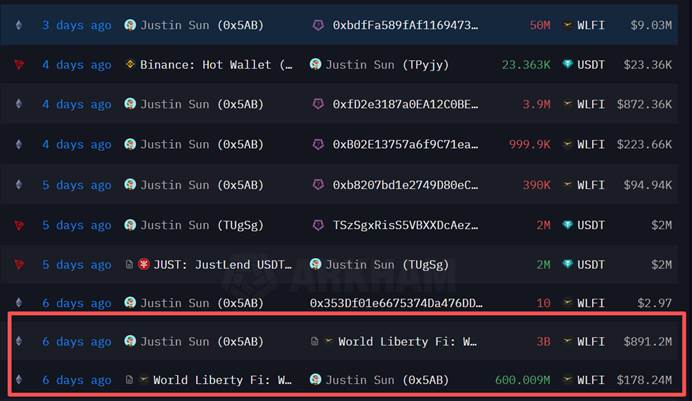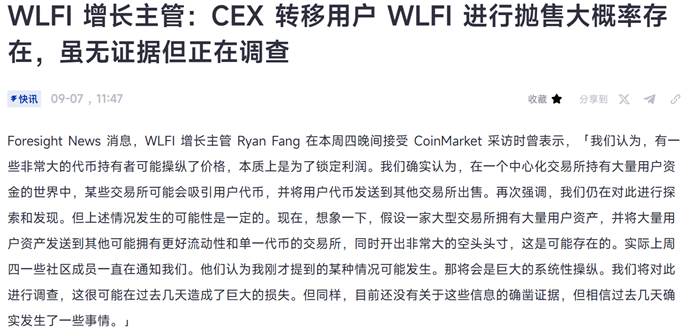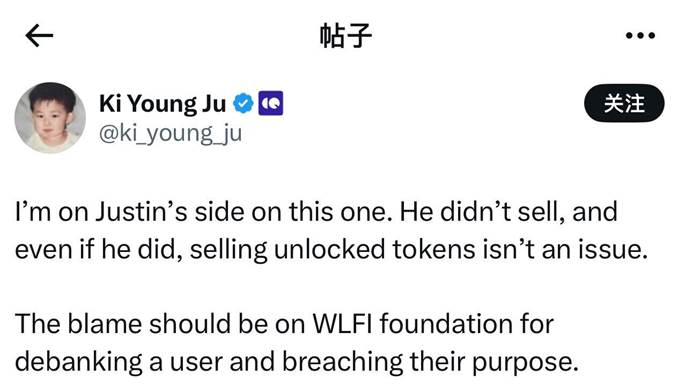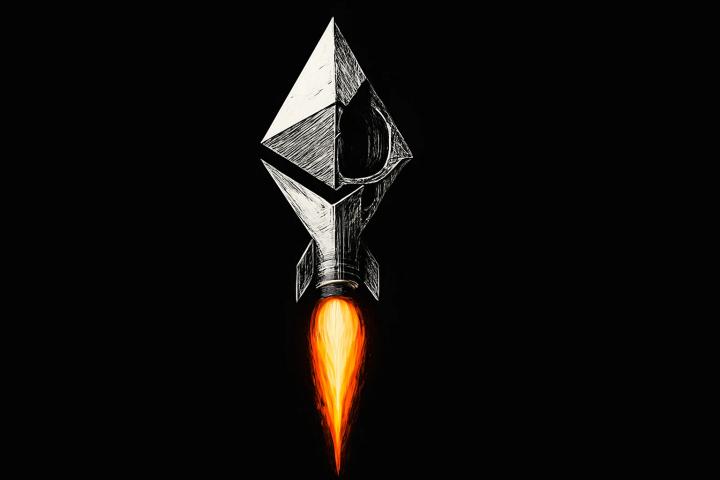Since its launch, the price of World Liberty Financial (WLFI), a token in which the US presidential family has a deep stake, has experienced dramatic price fluctuations. Following a sharp drop on its launch day, WLFI experienced another surge, reaching a peak of 33% in 24 hours, reclaiming 0.25 USDT on September 7th. Given the crypto's habit of winning over investors with rising prices and investors' faith in the Trump family, WLFI's initial post-launch crisis is expected to have been successfully navigated.
The market value soared, and Justin Sun, who owned more than 3 billion WLFI, undoubtedly win big again, with a floating profit of over 100 million US dollars overnight.
Just a day ago, he was attacked by many people as the biggest reason for the sharp drop in WLFI after its issuance.
At that time, the market was full of voices that were bearish on WLFI. Many people were criticizing Justin Sun, saying that he was selling coins and that his address was frozen. As a result, many people heavily short WLFI, and this wave of losses was devastating.
You can question Brother Sun, but you cannot question his ability to make money and his good luck. This sentence has come true again.
Mechanism defects lead to stampede shipments
When we review this incident, data shows that Justin Sun’s actions were clearly not the main reason for the sharp drop in WLFI after its issuance. The main reasons were the flaws in the token project model and the realization of previous gains.
WLFI, a DeFi project supported by the Trump family, has attracted much attention since its launch, but its token price quickly fell below its issue price, rising from $0.20 at the opening to around $0.5, and then quickly falling to around $0.15, which is similar to the trajectory of the TRUMP coin issuance.
Why are there similar trends? The gap between previous expectations and reality is too large.
WLFI's total supply is 100 billion, but the project unlocked approximately 24.67 billion to 27.15 billion tokens into circulation at launch, representing 24%-27% of the total supply. This significantly exceeded market expectations for an initial circulation of 5 billion and a gradual release. Consequently, around September 1st, WLFI was already receiving significant criticism, with many KOLs advising retail investors to stay away from WLFI, lest they face misfortune.
According to CoinMarketCap data, after WLFI was listed on multiple DEXs, including Ethereum, Solana, and BNB Chain, the initial circulation directly increased the possibility of a sell-off. At the same time, WLFI did not explain the reason for the one-time release of a huge amount of circulation.
WLFI's token economics design has significant shortcomings, particularly an imperfect lockup mechanism and relatively weak market maker support. While the project has a pre-set unlocking schedule (e.g., unlocking 5% of the total supply in September), the early unlocking was excessively large, and no corresponding lockup incentives were announced, significantly increasing the motivation of early subscribers to cash out in the short term.
Furthermore, during initial IPOs, projects typically utilize market makers to provide a floor for market fluctuations. This time, the apparent absence of market makers has led to insufficient liquidity, and with such a large-scale sell-off of unlocked shares, market makers may find themselves unable to provide a floor.

WLFI's understanding of market operations is as immature as if it had just entered the industry, which directly magnified the extent of the break-even.
Since its peak in January of this year, TRUMP coin has been in a continuous slump, with its market capitalization evaporating significantly, leaving many retail investors with a heavy price to pay. Unlike TRUMP coin's MEME attributes, WLFI, which aims to build decentralized finance, should have driven up market prices through slow construction. However, its initial market capitalization reached $30 billion, directly ranking it among the top ten crypto assets, making subsequent valuation growth significantly weak.
Retail investors have learned from Trump's mistakes how to "cash out quickly," and a sell-off initiated by WLFI is a foregone conclusion. Even if there is a possibility that Sun Ge will dump the market, it is perfectly normal, but the question is: does Sun Ge have the chips to do so?
600 million VS 27.2 billion, I am afraid Sun Ge can't beat it
WLFI broke its issue price and plummeted, causing criticism against the project owner to intensify before and after the opening. At this opportune moment, rumors of Brother Sun "dumping" WLFI emerged. However, those who raised doubts relied solely on empty talk and did not provide any evidence.
Based on the principle of presenting facts and reasoning, as well as the traceability of blockchain, from the analysis of on-chain data and timeline, it can be seen that this accusation was just a joke. As for whether it was later used maliciously, everyone has their own opinions.
As an early investor, Sun purchased $75 million worth of WLFI tokens. On September 1st, Sun's unlocked share was only about 600 million WLFI (20% of the unlocked amount), which was a drop in the bucket compared to the approximately 27.2 billion unlocked in the first phase of the project.
There is also an episode here. The unlocking of WLFI was completed by first returning all tokens through early subscribers, and then the project party returned the unlocked tokens in the first phase. It can be seen that they did not design a good lock-up and unlocking mechanism at the beginning. It was more like a temporary solution .

Furthermore, according to analysis by Nansen, a prominent industry research firm, the price drop occurred hours before Sun's transfer to Binance, primarily due to institutional selling pressure and large orders on decentralized exchanges (DEXs), rather than his own actions. While Sun's transfer of approximately 55 million tokens was significant, eight other top holders cashed out on the first day of trading, representing the primary source of pressure .
On-chain tracking shows that most of Sun Ge’s WLFI holdings have not moved. Although the WLFI team froze his wallet (claiming to prevent phishing), they also admitted that this was more of an internal decision of the project rather than a conclusive evidence of a market crash.

Opinions within the industry are divided as to whether Sun was behind a massive market dump. On-chain data clearly doesn't support the conclusion. However, as a prominent figure in the industry, and with his canary-like nature, some of his actions are often exaggerated and interpreted, making it difficult to say they didn't significantly impact the market.
However, the industry generally believes that freezing Sun's account severely undermines the project's "decentralized philosophy." For a project claiming to be decentralized finance to be able to so easily freeze the vast assets of an early investor through centralized means is completely contrary to its stated decentralized philosophy. This demonstrates that WLFI's decentralized governance may have significant flaws.
CryptoQuant CEO Ki Young Ju posted on social media that he supports Justin Sun sale of unlocked tokens and believes there is nothing wrong with it. He said that the WLFI Foundation should be held accountable because its "de-banking" of users violates its own founding purpose.

The fog is deep and the short position has suffered heavy losses
In this WLFI IPO debacle, Sun "passively"win big, while others like Maji, who seized the opportunity to go long, also made a killing. The project passed its first post-launch test. So who are the losers?
Clearly, short sellers were misled by market sentiment. Many investors, influenced by market sentiment, short WLFI heavily after the price dropped, suffering heavy losses. Data shows that WLFI saw $10.41 million in short positions liquidated in the last 24 hours!
Don't underestimate the dark side of trading. It's hard to say there aren't profit motives behind all the gossip. Those who criticize Sun Ge and short WLFI may simply dislike him, but they could also be long hoping to pick up shares at a low price and liquidate short positions. Every additional pessimistic atmosphere they create increases their profits.
Data shows that as of September 7, the WLFI RSI indicator was approaching oversold territory, indicating near-limit short-term selling pressure and a strong rebound. Important factors and facts, such as WLFI's strategic partnership with ALT5 Sigma, the steady progress of USD1, and the Trump family's global influence, have been intentionally or unintentionally overlooked.
It's hard to argue that there isn't a larger game at play here. Those who lack independent judgment and are easily swayed by market sentiment are easily fooled.
To borrow Zhao Benshan’s classic quote, “Haiyan, please be more careful!”






